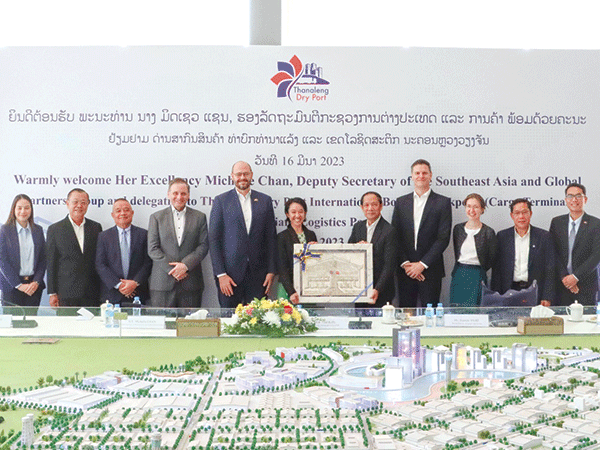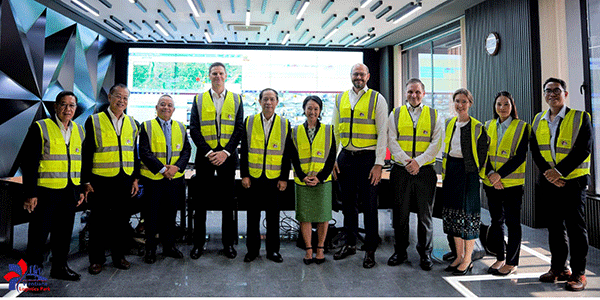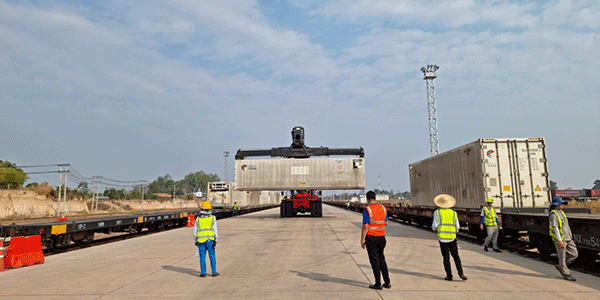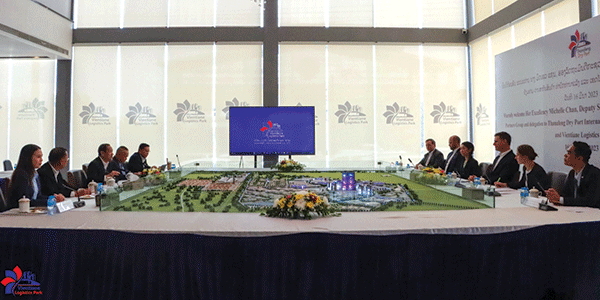 |
| Mr Alounkeo Kittikhoun (right) presents a gift to Ms Michelle Chan. |
Thanaleng Dry Port ‘a boon for entrepreneurs’, visiting Australian delegation learns
Laos’ expanding integrated logistics and transport links are shortening routes to regional and global markets through cost-effective services.
The Thanaleng Dry Port in Vientiane has lowered logistics and transport costs, boosting competitiveness and providing lucrative opportunities for entrepreneurs, its developer has told a visiting Australian delegation.
Located near the international checkpoint at the first Mekong friendship bridge linking Vientiane with Thailand’s Nong Khai province, Laos’ first integrated logistics centre has reduced logistics costs, especially at this border crossing.
 |
| Mr Alounkeo Kittikhoun (fifth left) and guests gather for a group photo at the Thanaleng Dry Port control room. |
Open for service since December 2021, the dry port has helped cut transport costs from US$1,700 to about US$1,120 for trucks travelling between Vientiane and Thailand’s Laem Chabang sea port, the dry port’s Managing Director Sakhone Philangam said.
“We have achieved some major breakthroughs that reduce overall costs by about 25 percent,” he told the guests.
The Australian delegation, comprising Deputy Secretary of Southeast Asia and Global Partners Group Michelle Chan, Australian Ambassador to Asean Will Nankervis, and Australian Ambassador to Laos Paul Kelly and other delegates, visited the multimodal transport dry port in Vientiane on Thursday to learn about its operation and the opportunities it offers.
Housing the one-metre-gauge Laos-Thailand Railway and the standard-gauge Laos-China Railway, an important trade gateway between China and Southeast Asia, the dry port is also facilitating logistics and transport links between the region and Europe.
Using the China-Europe rail network, cargo shipped from Southeast Asia can reach European markets in about two weeks, much shorter than the 45 days using sea transport.
In the region, “We are the shortening transport [time] from Vientiane to the Chinese border, taking about four hours now,” the director said, referring to rail transport.
The dry port has seen rapid growth in its cargo services. During the first year of operation, it processed 46,000 containers. The volume is expected to increase to between 100,000 and 120,000 containers this year.
As part of the Lao Logistics Link (LLL) project, being developed and operated by Petroleum Trading Lao Public Company (PetroTrade) in partnership with the governments of Laos and Vietnam, the dry port - one of the planned nine dry ports in Laos - is set to become a logistics connector. It links to several dry ports across the country and to sea ports in the region.
The LLL project also includes the Vung Ang sea port in Vietnam’s central Ha Tinh province, a planned railway linking the sea port to Vientiane, and a planned logistics park in Laos’ central Khammuan province, through which the railway will run.
From Vung Ang, the transport of freight to China will take just 18 hours to reach the world’s second largest economy and a market of 1.4 billion consumers.
 |
| A crane transfers cargo between the Laos-Thailand Railway (left) and the Laos-China Railway (right). --File Photo Thanaleng Dry Port |
“So we are shortening the timing of transit,” Mr Sakhone said.
Recently, PetroTrade and Vietnam’s DEOCA GROUP signed a joint venture agreement to push forward the Mu Gia-Vung Ang railway, a section of the planned Vung Ang-Vientiane railway. Once it is operational, rail transport will lower costs further.
Through Vung Ang, freight could be shipped to major markets including Japan, South Korea and even Australia, said Mr Alounkeo Kittikhoun, President of the Executive Board of Strategy & Planning of PTL Holding - the parent company of PetroTrade - in response to questions raised by the Australian delegates.
To maximise the trade and investment potential delivered by the dry port, the Lao developer recently broke ground for construction of a US$547 million logistics park on a 327-hectare site in Hadxaifong district, Vientiane.
The logistics complex includes a tank farm, export processing centre, logistics park, free trade zone, and technology and halal hubs, where investors are welcome to do business.
Companies manufacturing or assembling goods in Laos can benefit from Laos’ country of origin status, whereby developed countries waive or reduce tariffs on imports from Laos, Mr Sakhone said.
More than 30 countries including Australia, Canada, the European Union (EU 28), Japan, New Zealand, Norway, Russia, Switzerland and Turkiye have extended the privilege to made-in-Laos products.
Investors are also offered significant tax breaks in line with Lao laws and regulations.
 |
By Advertorial Desk
(Latest Update March 22, 2023)
|